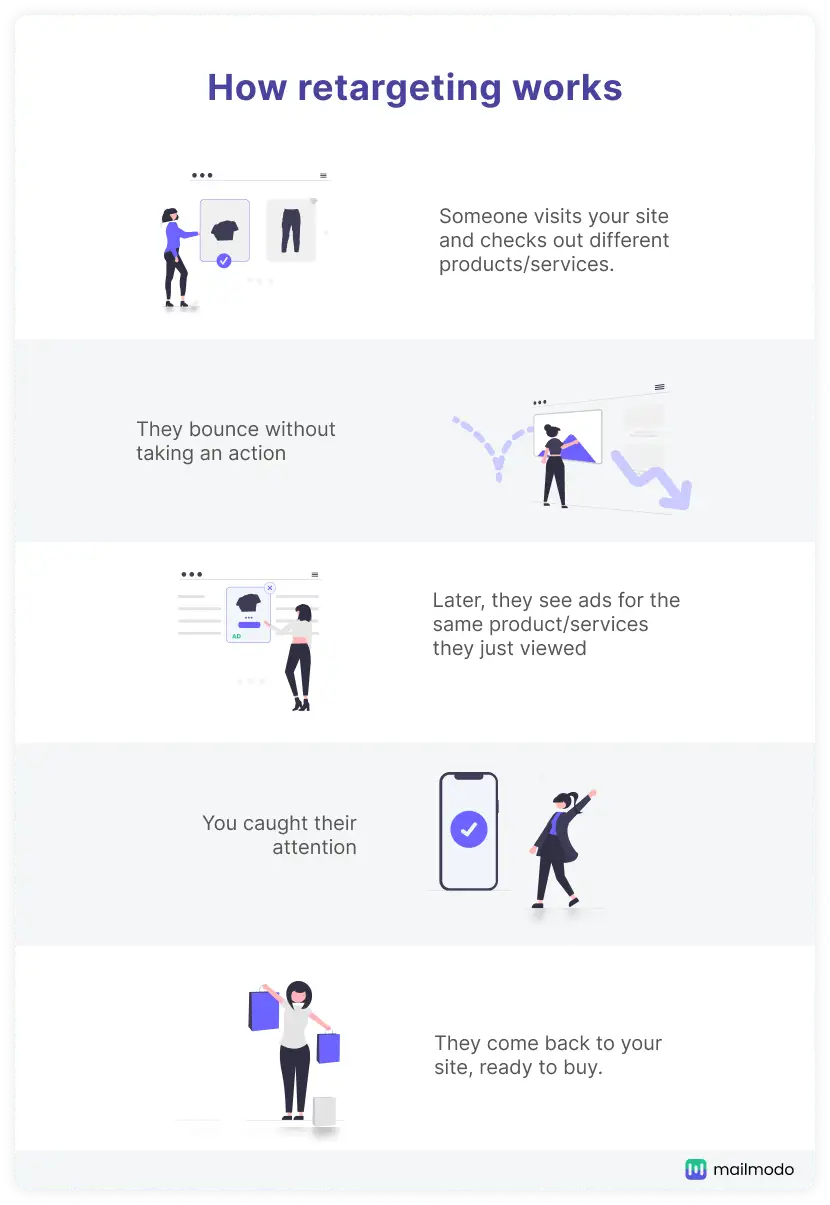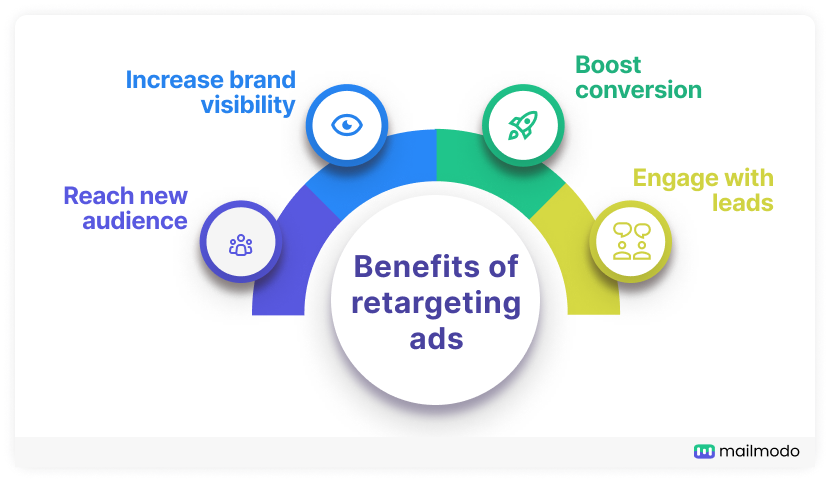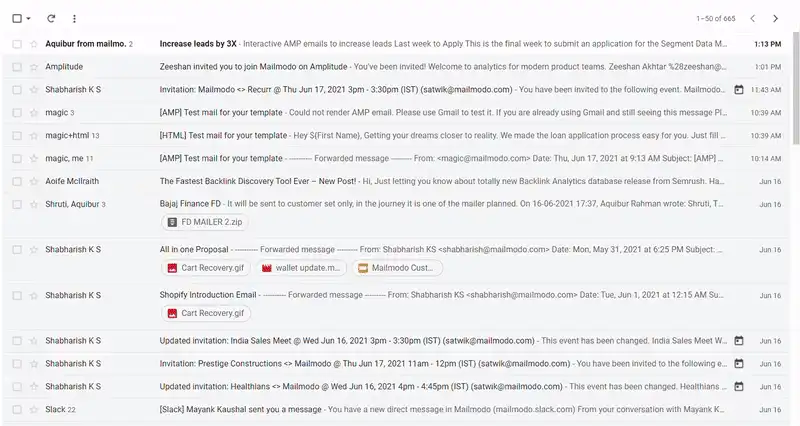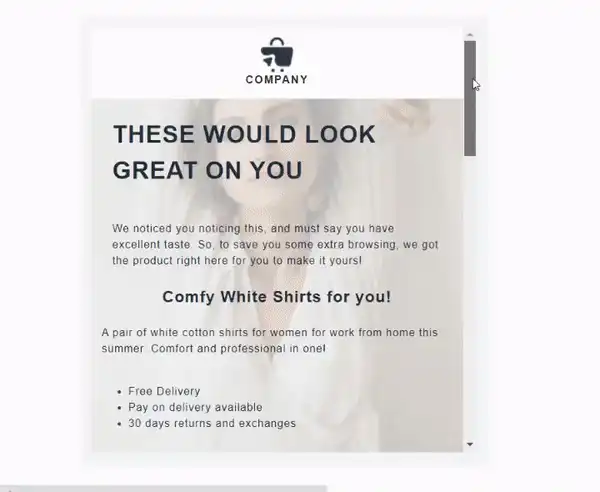Retargeting is an umbrella term for marketing to prospective users by sending your best offers to either people who have already visited your website or who have bought something from you earlier.
Don't worry if you've never used retargeting before. In this guide, we'll go over the basics of how it works, how you can use it to support your bigger marketing goals, and show you how to run a retargeting campaign.
Let's explore the world of retargeting to recover your lost sales and engage your leads today.
Table of contents
What is retargeting?
Retargeting is an advertising strategy where you target visitors who visited your site but bounced without buying any product or services.
Using the site and cookie data, you can set up retargeting ad campaigns like display ads, search engine ads, or Linkedin ads to remind visitors to visit your site again.
You can use retargeting to
Show your top-selling products to those who already showed an interest in your business.
Promote seasonal campaigns and generate higher ROI.
Showcase new product launches to both existing and prospective customers.
How do retargeting ad campaigns work?

The retargeting process goes like this:
Someone visited your website and checked out different products/services, pages, blog posts, etc. They closed the window without taking any action and went back to surfing the internet.
While scrolling, they came across your brand's ad showing a similar product they just viewed. You caught their attention, and they're now convinced to go back to your site and buy this time.
Retargeting was effective in this case because it focused your advertising spend on someone who demonstrated interest in you and was already familiar with your products/services.
The structure explained above is how retargeting works, but there are two different approaches to this process.
Types of retargeting
There are two types of retargeting: Pixel-based and list-based. Both of these differ depending on which users you want to retarget.
Pixel-based retargeting
In this type, the retargeting ads are displayed to visitors who visit your site. They might or might not be a part of your database already. The content shown is similar to the ones they already viewed on your site.
Pixel-based retargeting works like this:
You lace a javascript code (known as a pixel) on your site's web pages > An individual visited your site > A website cookie gets installed on their browser tracking their interaction > Users left without taking any action and go surf the web > The embedded cookies notifies the retargeting platform to show the relevant ads based to the visitor.
Pros: Ads are shown based on the user's behavior and interaction on your site. Hence, the chances of recovering those users are higher.
Cons:
Not every user who comes to your site will be interested in your product/services. They might be using your site for research purposes. In such cases, showing ads to these users will not give you any ROI.
List-based retargeting
You'll often have a list of users interested in your product/services. For instance, an email list of potential users or a sales team might have a lead database. These people are further down the conversion funnel and have higher chances of converting.
So, you upload these lists into the retargeting platform's database, and it will run ads for such users.
Pros:
There are higher chances of getting conversions as these users are in the middle or bottom of the sales funnel.
Cons:
The emails your users have given you might differ from those they use on other social platforms. In that case, they won't see your ads.
Difference between retargeting and remarketing
Often these two terms are used interchangeably but there are slight variations. Let’s discuss that.
| Retargeting | Remarketing |
|---|---|
| Retargeting is done via paid ads to show relevant ads to the target audience who has visited your site or social media profile. | Remarketing is done via email to engage recipients who have already done business with your brand. |
| Helps you reach and capture new audiences. | Helps you re-engage inactive or old customers. |
| Helps in acquiring new customers. | Helps in retaining the existing customers. |
Benefits of retargeting

Retargeted marketing can help you boost your sales and offers the following benefits:
• Helps you reach a new audience
These ads are shown to visitors who have visited your website or similar websites in your industry. That way, you can develop the right targeted ads to showcase your product/services and reach out to such people.
• Increase brand visibility
A good rule of thumb to help users make up their minds about buying is to make sure they hear your message 7 times. Before visitors purchase, they need to know you, the value your product/services offer, and the benefits they'll get from using them. You can't expect them to convince them the first time they visit your site.
So, retargeting helps you build that trust with them by nudging them with relevant ads on different platforms and maintaining brand visibility. The more they come across your ads, the more they'll become aware of your brand.
Related guide: How to Build Brand Awareness to Increase Brand Recall
• Boost conversions
When someone visits your website, it shows they're somehow interested, but they bounced due to several reasons. With retargeting and their data at your fingertips, you can target them with relevant ads to rekindle their interest and push them to complete the action. Hence, they might take action, thus boosting your conversions.
• Helps B2B to engage with the leads
The B2B conversion cycle is often long because of the involvement of many decision-makers. That's where retargeting can help your B2B brand.
You can target different stakeholders involved in the decision-making process by showing relevant ads and sponsored content. As these ads will help you engage with them during each stage, it will help build brand visibility and nudge them towards conversion.
Related guide: 11 Strategic Ways to Capture High-Quality B2B Leads in 2022
How to retarget your audience on different platforms?
You can use any of the following channels for retargeting:
Email retargeting
Emails are the best way to retarget your site's visitors if they are on your email list. It is a more personal way to reach out to your visitors than other channels. So, the chances of getting a response are much higher.
You can send the following emails to retarget your site's visitors:
Cart abandonment emails: These emails are best to remind users what they left in their cart and nudge them to buy it. To ensure users complete the purchase, here's what you can do:
Give discounts or coupons to entice them to complete the purchase.
Use compelling images and other visuals to capture their attention.
Use AMP for email to add carts within the email and allow users to complete the transaction without any redirects. It helps eliminate the friction in the conversion process, and dance users tend to convert more.
Here is how a cart abandonment AMP email works:

Get this cart abandonment email template
- Browse abandonment emails: Track users browsing behavior on your site and send out these emails to show them relevant products and services. These emails help users explore options within their email, and as the suggestions are similar to what they were looking for, the chances of getting conversions are higher.
Here's an example of browse abandonment AMP email showing product users viewed along with relevant recommendations.

Related guide: How Can You Use Email Retargeting to Increase Sales
Facebook retargeting
With a huge user database, Facebook has access to loads of user data that you can leverage to show relevant ads to customers you want to retarget.
Facebook allows you to create different ad formats to showcase your product/services in an enticing way that propels users to click and take action. Besides, you can rekindle the interest of visitors by personalizing these ads.
HDFC Life got a 19% increase in sales for the Click 2 Wealth product and a 3.8-point lift in brand awareness using Facebook's video ads and core audience tool. So, check out Facebook retargeting tools and capture your lost visitors.
If you want to know how to set up a retargeting ads campaign on Facebook, check out Facebook's guide.
Google Ads retargeting
Google is among the biggest and most popular search engines, with a market share of 92.07%. Running retargeting ads on Google is the best way to enhance your reach and improve brand visibility. With Google, you get several effective ads option, including:
Show display ads to past visitors when they browse other websites or apps.
Show dynamic ads based on the product and service they viewed on your site.
Ads on SERP on keywords related to what users interact with your website.
Show ads based on their interaction with your Youtube channel.
Show ads to users on your email list if they've signed up on Google using the same email address.
Chumbak, a B2C brand, saw a 35% increase in conversions within 3 months using Google ads. These ads helped them reach out to audiences that they otherwise won't have, given their limited budget.
You need to create a remarketing list in Google Ads (RLSA) to use these ads. To learn more, check out Google's guide for adding remarketing lists in Google ads.
Linkedin retargeting
If you're a B2B, retargeting ads on LinkedIn can have more leads than any other social channel.
Why?
Because companies, professionals, decision-makers, etc., all hang out on LinkedIn, giving you a perfect opportunity to reach out to your target audience and show them relevant ads.
Scorpio Healthcare, a digital healthcare provider, shows how to use Linkedin to retarget users. They got a 56% conversion rate using the LinkedIn Matched audience tool and sponsored content.
So, if your audience hangs out on Linkedin, go and leverage it to re-engage your leads.
Retargeting best practices
Here are a few best practices to follow for effective retargeting:
Segment your audience to create highly relevant ads and increase your chances of getting conversions.
Optimize your landing pages to grab users' attention when they revisit your site.
Don't rely on guesswork. Instead, run A/B testing to get statically significant data and optimize your ads accordingly.
Use cross-selling and upselling to target users who have already made a purchase and compel them to buy other products.
Be transparent about using website cookies to collect users' data.
Ensure that you collect data as per GDPR and CPRA guidelines.
Integrate your retargeting campaigns
The next step you should take on your retargeting journey is integrating your retargeting ad campaigns with other ads. It will help you gain visibility in the user's buying journey during each touchpoint.
The paid ads will drive traffic to your site via email, Facebook, and Linkedin. When visitors leave without taking any action, retarget them with retargeted ads.
If they buy, nudge them with a thank you email to keep the conversation going.
So, with an integrated marketing campaign, you can build stronger relationships with your visitors, turn them into customers, and increase your ROI. Read our guide to determine which strategies you can use to integrate different (read: contrasting) marketing channels.
What you should do next
Hey there, thanks for reading till the end. Here are 3 ways we can help you grow your business:
Talk to an email expert. Need someone to take your email marketing to the next level? Mailmodo’s experts are here for you. Schedule a 30-minute email consultation. Don’t worry, it’s on the house. Book a meet here.
Send emails that bring higher conversions. Mailmodo is an ESP that helps you to create and send app-like interactive emails with forms, carts, calendars, games, and other widgets for higher conversions. Get started for free.
Get smarter with our email resources. Explore all our knowledge base here and learn about email marketing, marketing strategies, best practices, growth hacks, case studies, templates, and more. Access guides here.


